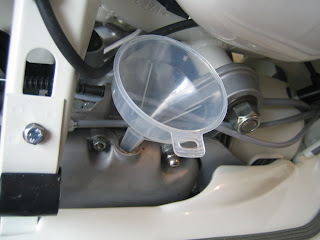Easy to forget, but probably fatal for your engine if you do it.
Remove the upper oil filler plug.
Make sure you do not loose the filler plug fibre washer.
Use a funnel in the engine filler hole.
and add 750ml (three quarters of a litre) to a dry engine.
Remember, we are adding this to a totally dry engine, so after initial running checks and setup, we will be checking the levels again using the level plug as some oil will be lost when circulating the engine and soaking the clutch etc.
Normally, you will drain the oil using the lower of the two plugs in the bottom of the engine and check the level by filling from the top until it starts to seep from the upper two plugs (the level plug).
The engine is ready to roll.
Remove the upper oil filler plug.
Make sure you do not loose the filler plug fibre washer.
Use a funnel in the engine filler hole.
and add 750ml (three quarters of a litre) to a dry engine.
Remember, we are adding this to a totally dry engine, so after initial running checks and setup, we will be checking the levels again using the level plug as some oil will be lost when circulating the engine and soaking the clutch etc.
Normally, you will drain the oil using the lower of the two plugs in the bottom of the engine and check the level by filling from the top until it starts to seep from the upper two plugs (the level plug).
The engine is ready to roll.














































